We’ve just finalized our study into how online retail brands use data to support decision making within their organization. What our research uncovered might surprise you. Though before we take a look at some of the findings, let’s gain a greater context to the problem.
For today’s ecommerce brands, achieving sustainable growth is contingent on the effective use of the data at their disposal. It’s only by utilizing the right information that online stores can improve the critical aspects of their operations – positioning, audience, and advertising targeting and even product selection – to deliver satisfying ROI.
Why Is Data So Critical for Online Stores?
Few other businesses have to compete in such a broad market as ecommerce. Many online stores have to fight for each sale with their counterparts worldwide.
Such fierce competition results in too many challenges. Most stores suffer from low margins (even Amazon, an ecommerce giant, by all means, averages at 1.3% in operating margins, according to the Harvard Business Review.)
Then, there is the rising cost of running the business. Advertising, marketing, shipping, and many other factors contribute to lower profit potential as well.
The above, and more force online stores to become more mindful and conscious about their every decision, initiative, and investment.
That’s precisely where the data-driven approach to decision-making fits in. Data gives online retailers the advantage to back every decision with facts and move away from working on the gut feeling alone.
But do they use it for that purpose?

How Ecommerce Stores Use Big Data
The information below comes from Adverity’s global ecommerce executive study, called “Justifying Opinion with Facts.” The analysis, however, is mine.
In the study, we surveyed 100 ecommerce executives - Directors and Managers of eCommerce, Marketing, Marketing Technology, and Data Analytics – from around the globe. Our goal, to identify how much ecommerce stores rely on data already in their decision-making process, what challenges they face, and how they plan to embrace the data further.
Here are our findings.
Data-Driven Decision-Making
Back in 2011, Harvard Business Review wrote: “It’s not you — the world has become more complex.” The author’s followed the statement by comparing elements involved in decision-making in 1980 and at the time of writing.
Their words hold even stronger today.
A modern executive, marketer or growth manager face the severe challenge with making decisions based on a staggering number of factors, after all. Ones, as the HBR article points out, were isolated from one another just 30 years ago are bumping up against each other today.
What’s more, every single one of those factors relates to the data.
In our study, we found that, when faced with a crucial decision, only 53% of ecommerce executives consult the available information. 47%, however, admit openly to using their experience and gut feeling to make it.
For 60% of brands, making such a decision takes a considerable amount of time. Often, it also requires a committee to proceed.
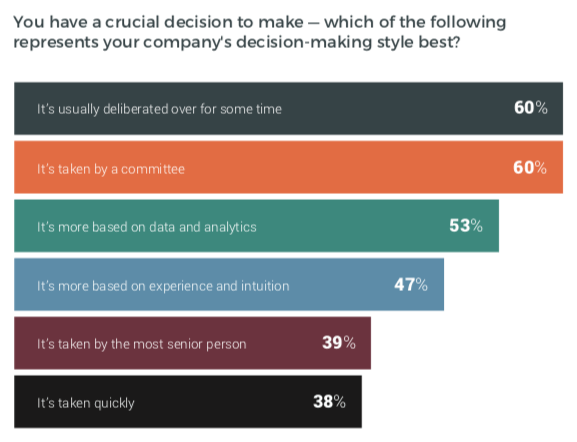
Data-Driven Marketing
The situation improves, however, once we go more granular, focusing on a single aspect of the company’s operations – marketing.
More and more brands turn their attention to a data-driven approach to promotion and advertising. Most have discovered the value of being able to personalize the customer experience, improve audience targeting and acquire new customers at a lower cost of acquisition by fine-tuning their marketing with the data.
It comes as no surprise, then, that 57% of stores call data the significant driver of their marketing strategy.
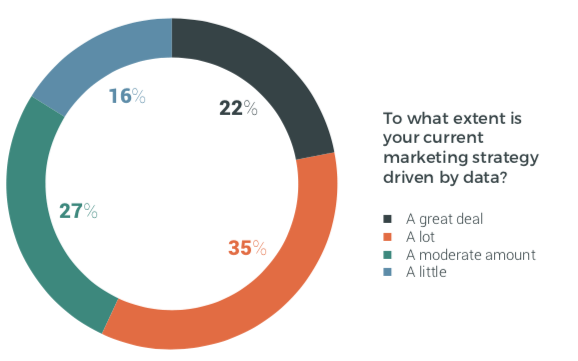
The majority of data-driven marketing focus goes towards the brand and product campaigns (note, I’ve discounted findings relating to physical stores on purpose here.)
However, when analyzing the data more in-depth, we discovered that most online stores use data to optimize their entire marketing ecosystem rarely.
The majority of our respondents (43%) focus their data efforts on optimizing a specific online activity. Be it campaign optimization, conversion optimization or more; they use the data for a single purpose only.
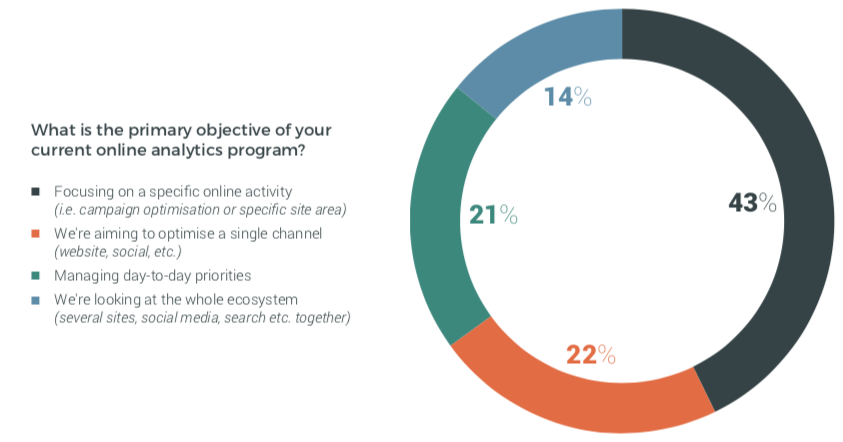
We’ve wondered about the reason for such data under-utilization. As it turns out, two factors affect it:
- Lack of a reliable solution to bring all the necessary information in one place to analyze. A staggering 25% of respondents voiced their concerns about lacking a data intelligence platform they could depend on. 33% still collect data in a spreadsheet.
- Lack of the right data. 20% of the stores we’ve interviewed voiced their concerns about the quality of their information. This brings us to another aspect of data-driven decision-making…
Data Sources – From Where Online Stores Get the Data
According to the data from ChiefMartech.com published recently, today’s marketing landscape encompasses a mind-boggling 7040 tools and solutions and growing.
(In comparison, eight years ago, the landscape included around 150 tools and solutions only.)
What’s more, much of these solutions provide proprietary data and information for marketing teams to use, analyze and incorporate in their decision-making process.
But does such wide access to the data make the process any easier? According to our data, not really.
The majority of businesses we included in the research use between six and 15 data sources only. 8% use fewer than three.
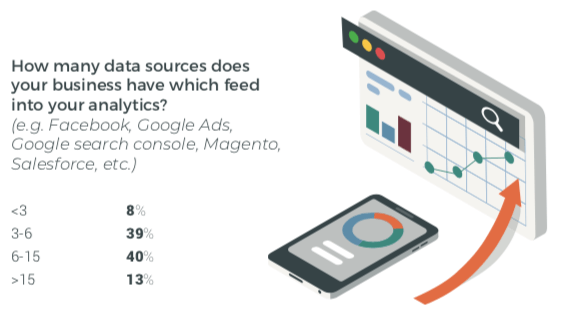
The most common data sources include social media advertising and display advertising, followed by web analytics and SEO data.
The above doesn’t surprise me much. All of those data sources provide easy to understand and actionable insights. They require a moderate level of experience to process and use, making them the most accessible information for marketers.
Are you struggling to organize your marketing data? Check out our 4 Golden Rules for Dashboard Best Practice.
What About Budgets for Data-Driven Programs?
Data isn’t free. At least, not all of it. Platforms, data connectors, data teams and processing the information require costs and budgets. Even if a company wishes to develop a data pipeline in-house, they face development expenses and employee costs.
Yet, only 24% of our respondents allocate more than 11% of their marketing budget to the data. 55% spend between 6% and 10% to acquire and process information and 21% devote less than 5% to run their data-driven program.
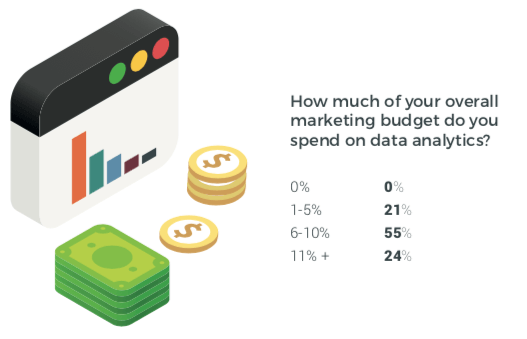
On the bright side, more than half of the study participants plan to increase data analytics budgets in 2020.












